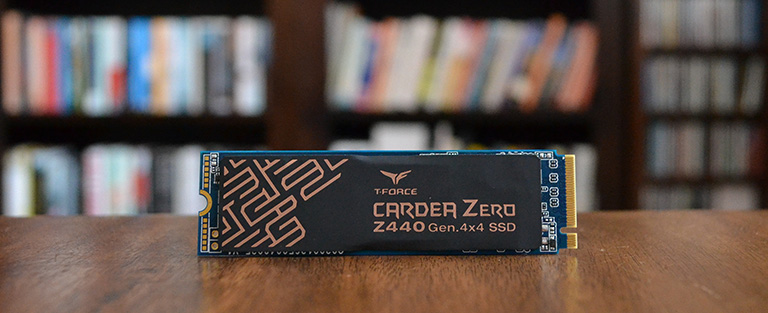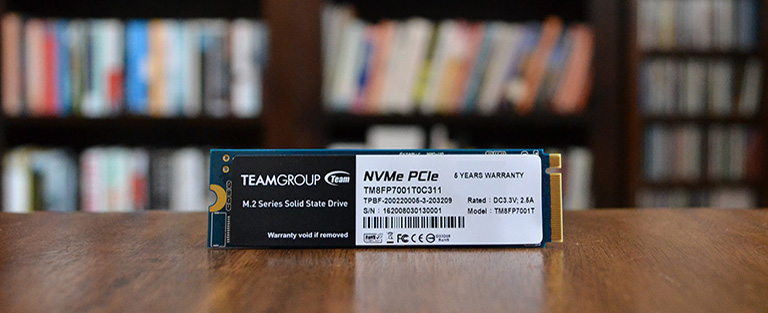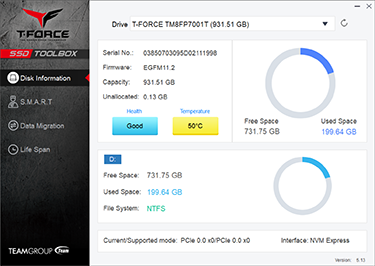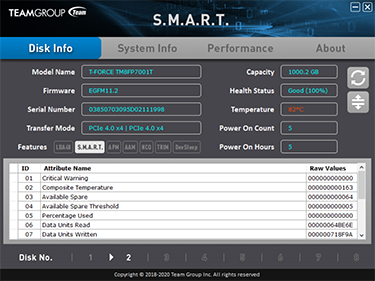Introduction
Remember the days of mechanical storage? The clickety-clack of heads moving over platters is a long-distant memory for many, replaced by speedier solid-state storage (SSDs). The latest iteration of SSDs, primed for leading AMD platforms, are built on a PCIe 4.0 interface and promise breathtaking sequential read and write speeds in excess of 4GB/s.
The familiar recipe for any vendor looking to play in this field is to pair the ubiquitous Phison PS5016-E16 controller with some tasty 96-layer 3D TLC NAND, presented together on an M.2 form factor. Arguably more popular for its range of DRAM and basic SSDs, TeamGroup has duly taken advantage of cutting-edge technology to release such a drive. Enter the T-Force Cardea Zero Z440.
Specifications |
||||||
|---|---|---|---|---|---|---|
| Series | TeamGroup T-Force Cardea Zero Z440 |
|||||
| Nominal Capacity | 1000GB |
2000GB |
||||
| Controller | Phison E16 |
|||||
| NAND | 96-layer 3D TLC |
|||||
| Encryption | N/A |
|||||
| Interface | PCIe Gen 4 x4 |
|||||
| DRAM | SK hynix DDR4 |
|||||
| Sequential Read Speed | 5,000MB/s |
|||||
| Sequential Write Speed | 4,400MB/s |
|||||
| Random IOPs (4KB Reads) | 750K IOPS |
|||||
| Random IOPs (4KB Writes) | 750K IOPS |
|||||
| Peak Power | N/A |
|||||
| Idle Power (PS3) | N/A |
|||||
| Sleep Power (PS4) | N/A |
|||||
| Available Form Factors | M.2 2280 |
|||||
| Endurance | 1,800TBW |
3,600TBW |
||||
| Life Expectancy | 1.7m hours |
|||||
| Warranty | 5 Years |
|||||
| Current Retail Price | £200 |
£380 |
||||
Unlike others, TeamGroup limits its range to two drives offering either 1TB and 2TB capacities costing £200 and £380, respectively. Looking at 1TB models, that's £30 more than the likes of the Sabrent and still 10 percent dearer than Corsair drives using the same underlying technology.
Our 1TB review sample mates the controller with four-chip Kioxia (formerly Toshiba) NAND identified as TABBG65AWV. If you care about part codes, it's an 8-die (AB) IC using 96-layer TLC (G65). It also has two 512GB SK hynix DDR4 chips (H5AN4G8NBJR) responsible for holding the flash translation layer metadata. This combination of Phison, Kioxia and SK hynix is found on every PCIe 4.0 drive we have seen thus far. Firmware and presentation is all that's different between them.
Cardea Zero's topside NAND, controller and DRAM is covered by a thin copper sticker aiding thermal performance, though as you will see later on, the drive does become rather warm under load. We can overlook the fact that no heatsink-clad version is available as most enthusiast-class AMD PCIe 4.0-supporting chipsets have their own integrated M.2 heatsinks.
We'd prefer a black PCB instead, matching the aesthetic on most premium gaming motherboards, and we'd describe TeamGroup's styling as staid rather than racy.
The back, which is in closer contact to the motherboard's PCB, has a simpler paper sticker that, again, is innocuous in the looks department. Unsurprisingly, overall specifications are in line with other drives featuring the same technology, so expect up to 750K IOPS on 4K reads and writes, endurance that's approximately one complete drive write per day over the five-year warranty period, and the usual near-2m hours MTBF.
TeamGroup offers two utilities to monitor the Cardea Zero's characteristics though you have to manually search for them - going to the correct download page shows nothing, strangely. The SMART and ToolBox replicate most of what is shown in the other application.
A couple of notes. The temperature monitoring doesn't auto-update itself; you have to manually refresh the page for it to register. There's no clear way to update the firmware in either utility, and the only truly useful feature is the ability to migrate data from one drive to another. That said, we'd still prefer the flexibility of Acronis software that's bundled in with most of the competitor models.
Priced on the higher side of Phison E16-equipped drives, let's now run it through the usual benchmark gauntlet.













